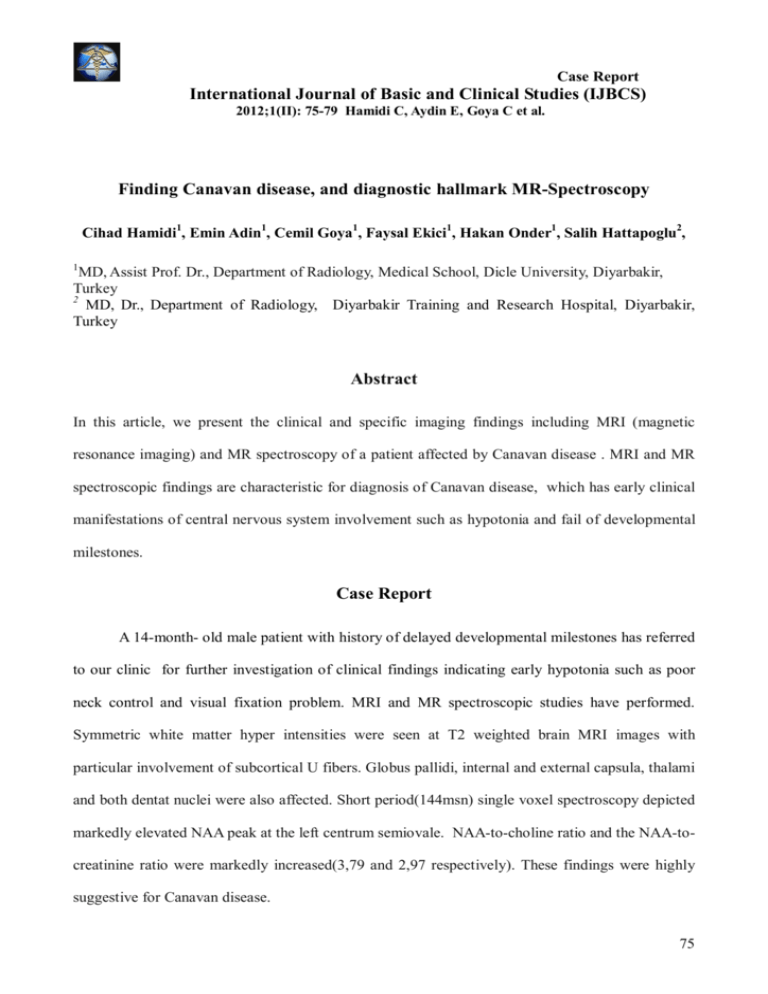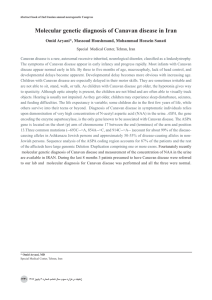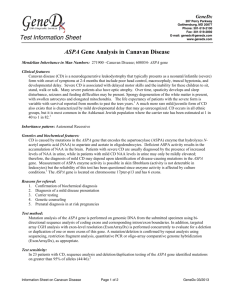Finding Canavan disease, and diagnostic hallmark MR
advertisement

Case Report International Journal of Basic and Clinical Studies (IJBCS) 2012;1(II): 75-79 Hamidi C, Aydin E, Goya C et al. Finding Canavan disease, and diagnostic hallmark MR-Spectroscopy Cihad Hamidi1, Emin Adin1, Cemil Goya1, Faysal Ekici1, Hakan Onder1, Salih Hattapoglu2, 1 MD, Assist Prof. Dr., Department of Radiology, Medical School, Dicle University, Diyarbakir, Turkey 2 MD, Dr., Department of Radiology, Diyarbakir Training and Research Hospital, Diyarbakir, Turkey Abstract In this article, we present the clinical and specific imaging findings including MRI (magnetic resonance imaging) and MR spectroscopy of a patient affected by Canavan disease . MRI and MR spectroscopic findings are characteristic for diagnosis of Canavan disease, which has early clinical manifestations of central nervous system involvement such as hypotonia and fail of developmental milestones. Case Report A 14-month- old male patient with history of delayed developmental milestones has referred to our clinic for further investigation of clinical findings indicating early hypotonia such as poor neck control and visual fixation problem. MRI and MR spectroscopic studies have performed. Symmetric white matter hyper intensities were seen at T2 weighted brain MRI images with particular involvement of subcortical U fibers. Globus pallidi, internal and external capsula, thalami and both dentat nuclei were also affected. Short period(144msn) single voxel spectroscopy depicted markedly elevated NAA peak at the left centrum semiovale. NAA-to-choline ratio and the NAA-tocreatinine ratio were markedly increased(3,79 and 2,97 respectively). These findings were highly suggestive for Canavan disease. 75 Case Report International Journal of Basic and Clinical Studies (IJBCS) 2012;1(II): 75-79 Hamidi C, Aydin E, Goya C et al. Figure 1: Aksial T2 MR image shows bilaterally symmetric increased signal intensity within cerebral white matter with involvement of subcortical arcuate fibers Figure 2: Koronal T2 MR image shows bilaterally symmetric increased signal intensity within cerebral white matter and dentat nucleus 76 Case Report International Journal of Basic and Clinical Studies (IJBCS) 2012;1(II): 75-79 Hamidi C, Aydin E, Goya C et al. Figure 3: Single-voxel MR spectroscopic image of left parietal white matter reveals markedly elevated NAA peak. Spectrum shows ratios of NAA to choline (Cho) (2.97), NAA to creatine (Cr) (3.79). The choline and creatinine peaks are within normal limits. Discussion Canavan disease, also known as spongiform leukodystrophy, is an autosomal recessive disease caused by mutations in the short arm of chromosome 17 resulting in deficiency of aspartoacyclase which catalyzes breakdown of NAA. Excessive accumulation of N-acetylaspartate is responsible for central nervous system changes1. 77 Case Report International Journal of Basic and Clinical Studies (IJBCS) 2012;1(II): 75-79 Hamidi C, Aydin E, Goya C et al. As a neurodegenerative disorder, Canavan disease, could show early sign of central nervous system involvement starting with antenatal period in some cases. Infants affected by Canavan disease delay in acquisition of milestones. Early motor skills such as suck, visual fixation and head control fail to develop. Hypotonia is followed by spasticity. Macrocephaly is seen in most cases. Canavan disease has rapidly progressive clinical course and poor outcomes with a mean survival time of 3 years2,3. Poor suck and head control problems indicating early hypotonia were also recognized by parents of our patient. Abnormal large head was accompanying the findings, however, hypertonia was not evident by the time we report the case. Diagnosis is based on the laboratory, radiology and histopathology.Prenatal diagnosis is possible by measurement of NAA in amniotic fluid. Patients affected by Canavan disease have increased NAA levels in urine, blood, CSF, and the brain. Imaging modalities, especially MRI and MR spetroscopy, are highly demonstrative for disease, but definitive diagnosis usually requires brain biopsy or autopsy. Symmetric white matter hyper intensities are seen at T2 wighted brain MRI studies. Particular involvement of subcortical U fibers is characteristic. Thalamus, basal ganglia, periventricular region, brainstem and cerebellum may be affected variably. Markedly elevated NAA peak accompanying increased NAA-to-choline ratio and NAA-to- creatinine ratio on MR spectroscopic studies along with characteristic white matter abnormalities are indicative for CD4,5. T2 weighted MRI images revealed symmetric hyper intense signal changes extending to subcortical U fibers, globi pallidi, internal and external capsule, thalami and both dentate nuclei of cerebellum in our patient. Short period(144msn) single voxel spectroscopy depicted markedly elevated NAA peak at the left centrum semiovale. Increase in the NAA-to-choline ratio and the NAA-to- creatinine ratio (2,97 and 3,79 respectively) were other significant findings suggestive for Canavan disease in our patient . 78 Case Report International Journal of Basic and Clinical Studies (IJBCS) 2012;1(II): 75-79 Hamidi C, Aydin E, Goya C et al. In conclusion, we report the clinical and radiological findings of a child affected by Canavan disease to demonstrate the importance of MRI and MR spectroscopic studies in the diagnosis. References 1.Gordon N., Canavan disease: a review of recent developments, EUR J Paediatr Neurol. 2001;5(2):65-69 2.Jung-Eun Cheon et al., Leukodystrophy in Children: A Pictorial Review of MR Imaging Features, RadioGraphics. 2002; 22:461– 476 3.Eveline C. Traeger and Isabelle Rapin, The Clinical Course of Canavan Disease, Pediatr Neurol. 1998;(18):207-212. 4.Michel SJ, Given CA 2nd. Case 99: Canavan disease. Radiology. 2006;(241):310–314. 5.Srikanth SG et al., Restricted diffusion in Canavan disease, Childs Nerv Syst. 2007; (23):465–468 79









